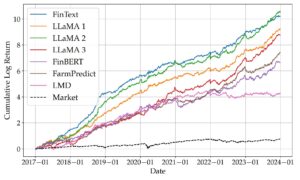Despite being substantially smaller, FinText has consistently outperformed state-of-the-art LLMs, including LLaMA 1, 2, and 3. In an asset pricing context, by constructing a zero-net investment portfolio, FinText has achieved a Sharpe ratio of 3.45, highlighting the importance of model specialisation and data over sheer model size. The FinText models have demonstrated not only superior performance relative to general-purpose LLMs but also have consistently surpassed specialised financial models such as FarmPredict, FinBERT, and LMD. To further substantiate these findings, our analysis has been extended by constructing alpha-adjusted portfolios, accounting for transaction costs, and exploring alternative configurations of these LLMs. These configurations have included models with smaller sizes, longer pre-training periods, and varying portfolio trading sizes. In all cases, the results have reinforced our initial conclusions. Furthermore, FinText models have been fine-tuned for trading purposes, and while they have achieved satisfactory performance, the simpler two-stage modelling approach has continued to outperform them.
This figure illustrates the cumulative log returns of long-short portfolios, comparing the performance of models from January 2017 to December 2023 including FinText, LLaMA 1, 2, 3, FinBERT, FarmPredict, and LMD. The market performance, represented by the S&P 500, is depicted with a dashed black line. All models consistently outperformed the market during the observation period. Although LLaMA 2 achieved a slightly higher cumulative log return by the end of the period, FinText generally exhibited superior performance across most of the dates.
